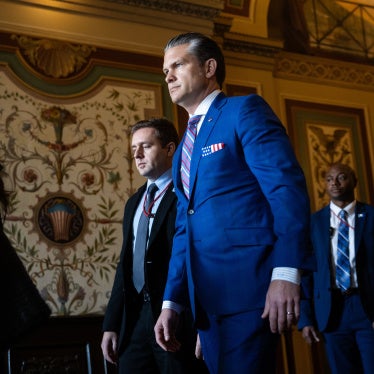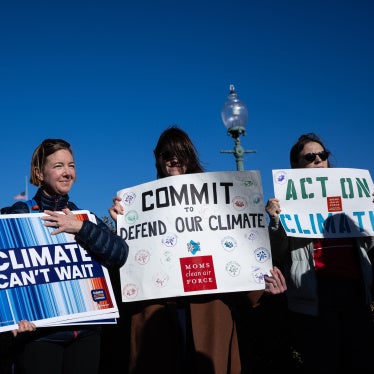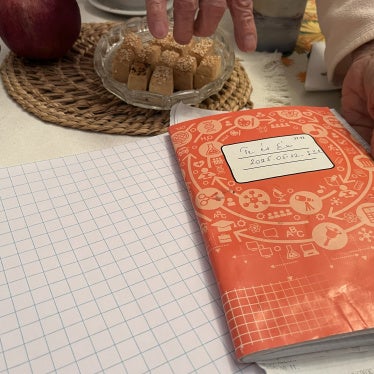September 9, 2014
The Honorable Jay Nixon
Office of the Governor
PO Box 720
Jefferson City, MO 65102
Re: Law Enforcement Response to Ferguson Protests
Dear Governor Nixon:
I write on behalf of Human Rights Watch to request that the state of Missouri undertake a comprehensive review of law enforcement responses to the protests in Ferguson that began on August 9, 2014. Specifically, we ask that the state examine the actions of all law enforcement agencies that sent personnel or equipment to the Ferguson area, including the state highway patrol, and devise recommendations to improve policies and practices related to law enforcement’s response to large protests. We also request that the terms of reference for such an inquiry be transparent and that the findings and recommendations be made public.
Human Rights Watch is a nongovernmental organization that monitors and reports on human rights issues in more than 90 countries around the world. Our work on the United States includes the compliance of the criminal justice system with international human rights standards.
The police killing of Michael Brown in Ferguson on August 9 resulted in strong emotions and calls for action within the city and surrounding communities. However, beginning the evening of August 10 and continuing mostly unabated for two weeks, law enforcement officers in Ferguson engaged in unnecessarily intimidating behavior that infringed upon the rights to assembly and freedoms of expression and the press, and at times involved unnecessary and excessive use of force.[1] Reports from August 10 and 11 include accounts of teargas fired at departing protesters[2] and police officers pointing assault rifles at passing motorists and unarmed individuals on foot.[3] Also widely documented are the events of August 13, when police used teargas[4] and rubber bullets[5] against peaceful protesters, residents and journalists.[6] Throughout the days that followed, reports of these tactics and others, including the use of long-range acoustic devices for crowd dispersal, were commonplace.[7]
Human Rights Watch spent several days in Ferguson beginning on August 17 to investigate and report on the reasons behind the protests, as well as the police response. As described below, we documented several apparent violations of the right to peaceful assembly and freedom of expression, incidents of possible excessive use of force, as well as actions that raised concerns over accountability and transparency of law enforcement.
Violations of Rights to Assembly and Freedom of Expression, Unnecessary Use of Force
The rights to peaceful assembly and free expression, in addition to being protected under the US Constitution, are protected under the International Covenant on Civil and Political Rights, which the US ratified in 1992.[8] The covenant not only applies to the federal government, but also to state and local governments.[9] Law enforcement personnel are obligated to protect and uphold those fundamental rights. Our own experience on the ground in Ferguson was that law enforcement officers often engaged in a disproportionate response to alleged public safety concerns, unfairly limiting the ability of protesters to peacefully demonstrate, including in the following specific cases that we documented:
- On August 17, 2014, Chris Renteria, a freelance photographer covering the protests, was walking with and photographing a group of peaceful marchers on West Florissant Avenue, in Ferguson, when three police armored vehicles surrounded the crowd, backing them into the driveway of the Emerson Electric building on West Florissant near Woodstock Road. That driveway was completely closed off at the other end, leaving the protestors with no exit. Once the armored vehicles had fenced in the protestors, Renteria said, “the tear gas started shooting.” An audio recording he took on that night indicates that police gave an order to disperse and started firing tear gas 3 seconds after giving that order. A line of officers then approached, causing Renteria and about 15 other protesters to back up onto an embankment that abutted the driveway and sloped up to about 10 to 15 feet high. “I had my camera and my press badge, I was holding my hands up, looking at the [officer] with a gun pointed at me and I was just inching [away], just trying to get out.” He added, “I put my camera in my bag, I contemplated jumping or climbing down ... there were cries from people that—for them to stop, you know, give us a minute to get down.” Renteria clambered down the side of the embankment for a few feet, and then jumped down to street level. He walked back to the media staging area by the McDonald’s, but “at that point the staging area, it was basically bombarded with tear gas.”[10]
- On August 13, 2014, Mary Chandler and her 15-year-old daughter Aniya were protesting with a group of several dozen others in a parking lot across the street from the Ferguson Police Department. The owner of the parking lot had given them permission to be there—so they were not trespassing.[11] Mary specifically chose to attend that protest and not the larger protest on West Florissant that day because she and her daughter had been present on West Florissant on August 11 and they had been hit by police tear gas. “I didn’t want take her back over there, so I felt like with my child it would be safer to come in front of the police station, which is ... a lot quieter, more peaceful,” she said. At around midnight, several police vehicles, including what she described as armored vehicles, pulled up to the curb by the parking lot. Mary said that “they had flood lights on us and they had ... about 40 or 50 men and they looked like military gear with M-16s, pointing them directly in our faces and they put the gun in my daughter’s face, telling [us] that we had to get off the property ... and that we were trespassing and if we did not move immediately, we would be thrown in jail.” Aniya did not know how many officers she saw, but she said there “a lot. An army. They looked like robots. One of them cocked his gun. I heard it .... A man jumped up and said ‘yo, yo, there are children here.’ I started crying.”[12]
- On August 11, 2014, Missouri Senator Maria Chappelle-Nadal was marching with about 150 young people on Northwinds Estate Drive. A line of police pushed protestors to a cross street that was closed off on the opposite end, and ordered them to disperse. When the protestors tried to leave, police told them to go the other end of the street—where it came to a dead end. Without giving any warning, police started fired tear gas canisters. Protestors were trapped on the dead end street for three hours, the Senator said, with police firing tear gas “every time we tried to move.”[13]
In addition to these cases, we received multiple reports of other incidents that raised similar concerns, which we urge the state to investigate thoroughly.
Lack of Transparency and Accountability in Law Enforcement’s Response to Protests
Multiple protestors we interviewed expressed concern that the police kept changing the rules, making it hard for protesters to conduct their demonstrations without a police backlash. A freelance journalist told Human Rights Watch, “The rules change day by day. It’s hard to know what to do.”[14]
Protestors expressed frustration that the police officers they approached often did not answer their questions. Human Rights Watch scanned the websites and twitter feeds of the various law enforcement agencies involved in responding to the protests, and found little if any useful information or instructions for protestors seeking to assemble peacefully without police interference.
On August 28, 2014, we submitted public records requests to the Missouri State Highway Patrol, the City of Ferguson Police Department, and the St. Louis County Police Department asking for information on every incident of police force used for crowd control in Ferguson, Missouri from August 9, 2014 through August 23, 2014. We have yet to receive a response, even though the three-day time period that the Missouri public records laws mandate for response has passed.
Problems in the response to the protests may have been exacerbated by the large number of separate local, county and state agencies involved and the lack of communication among them. Missouri state officials have been inconsistent regarding which agencies were involved and when.[15]
The failure to communicate and publicly designate a clear chain of command is problematic not only because it makes it difficult for the public to exercise their rights, but also because it robs civilians of the information necessary to lodge complaints in cases of officer misconduct, and leads to general mistrust. International human rights law applicable to the United States requires that victims have “accessible and effective remedies” to vindicate their rights.[16] Media reports from Ferguson that police officers were removing their nametags in order to prevent identification indicate that civilians concerned about the conduct of the police would have had no way to lodge complaints against specific officers’ use of force.[17]
Human Rights Watch found that a culture of mistrust and frustration with law enforcement was already present in Ferguson and nearby communities before the shooting of Michael Brown.[18] Many people we interviewed described years of police harassment and intimidation, preexisting factors that were exacerbated by the police response to the recent protests. Those who protested the killing of Michael Brown, as well as the public at large, deserve clear answers as to which police agencies and individual officers were responsible for making decisions to deploy teargas, rubber bullets, armored vehicles, and other questionable tactics.
Due to the numerous law enforcement agencies involved in the events in Ferguson, a state-level review of the actions of the various law enforcement agencies and their personnel in responding to the protests, and the failures that led to the violations that we and others have documented in Ferguson is crucial. A full and transparent investigation, with published findings and recommendations, into the conduct of all law enforcement agencies dispatched to Ferguson is an important step in addressing the many concerns of residents with respect to the police response and ensuring that similar abuses never happen again.
We urge you to immediately initiate such an investigation. Human Rights Watch will be in contact with your office to discuss this letter and our recommendations.
Sincerely,
Maria McFarland
Deputy Director, US Program
Human Rights Watch
cc: Lt. Gov. Peter Kinder
Speaker Timothy Jones
Dan Isom, Director, Department of Public Safety
[1] See United Nations Basic Principles on the Use of Force and Firearms by Law Enforcement Officials, Eighth United Nations Congress on the Prevention of Crime and the Treatment of Offenders, Havana, 27 August to 7 September 1990, U.N. Doc. A/CONF.144/28/Rev.1 at 112 (1990).
[2] Wesley Lowery, “Police Use Tear Gas on Crowd in Ferguson, Mo., Protesting Teen’s Death,” Washington Post, August 12, 2014, http://www.washingtonpost.com/news/post-nation/wp/2014/08/12/police-use-tear-gas-on-crowd/ (accessed September 8, 2014).
[3] Jeff Robertson, Associated Press photo, August 11, 2014, http://www.apimages.com/metadata/Index/Police-Shooting-Missouri/2c4fe90027464450aff042c958f9a2c2/ (accessed September 8, 2014).
[4] Trymaine Lee, “Ferguson police use tear gas on protesters, arrest at least 2 reporters,” MSNBC, August 13, 2014, http://www.msnbc.com/msnbc/reporters-ryan-reilly-and-esley-lowery-arrested-ferguson (accessed September 8, 2014).
[5] Jon Swaine, “Michael Brown protests in Ferguson met with rubber bullets and teargas,” The Guardian, August 14, 2014, http://www.theguardian.com/world/2014/aug/14/ferguson-police-teargas-rubber-bullets-michael-brown (accessed September 8, 2014).
[6] Harrison Jacobs, “Missouri Police Fire Tear Gas at TV Crew and Take Their Equipment,” Business Insider, August 14, 2014, http://www.businessinsider.com/police-fire-tear-gas-on-al-jazeera-america-tv-crew-and-then-take-their-equipment-2014-8 (accessed September 8, 2014).
[7] Josh Voorhees, “Everything That Went Wrong in Ferguson,” Slate, August 21, 2014, http://www.slate.com/articles/news_and_politics/politics/2014/08/ferguson_police_timeline_a_comprehensive_chronological_accounting_of_the.html (accessed September 8, 2014).
[8] International Covenant on Civil and Political Rights (ICCPR), G.A. res. 2200A (XXI), 21 U.N. GAOR Supp. (No. 16) at 52, U.N. Doc. A/6316 (1966), 999 U.N.T.S. 171, entered into force March 23, 1976.
[9] Ibid., art. 50 (“The provisions of the present Covenant shall extend to all parts of federal States without any limitations or exceptions.”)
[10] Human Rights Watch interview with Daniel Renteria, August 19, 2014, Ferguson, Missouri.
[11] Human Rights Watch interview with front desk receptionist, Andy Wurm Tire & Wheel, August 28, 2014, Ferguson, Missouri.
[12] Human Rights Watch interview with Mary Chandler, August 17, 2014, Ferguson, Missouri; Human Rights Watch interview with Aniya Betts, August 19, 2014, Ferguson, Missouri.
[13] Human Rights Watch interview with Senator Maria Chappelle-Nadal, August 29, 2014; Ruella Rouf, “Missouri Senator upset after tear gas thrown at her,” KMOV, August 13, 2014, http://www.kmov.com/news/crime/Chappelle-Nadal-upset-after-tear-gas-thrown-at-her-271183251.html (accessed September 8, 2014).
[14] Alba Morales (Human Rights Watch), “Dispatches: In Ferguson, a Police Failure to Communicate,” August 19, 2014, https://www.hrw.org/news/2014/08/19/dispatches-ferguson-police-failure-co...
[15] Dara Lind, “Why there wasn't accountability for the police in Ferguson,” Vox, August 14, 2014, http://www.vox.com/2014/8/14/6002291/ferguson-police-st-louis-county-in-charge-jay-nixon-tear-gas-officer-fired (accessed September 8, 2014).
[16] ICCPR, art. 2(3).
[17] Ben Mathis-Lilley, “Police in Ferguson Haven't Been Wearing Identification,” Slate, August 15, 2014, http://www.slate.com/blogs/the_slatest/2014/08/15/ferguson_police_nametags_reportedly_haven_t_been_worn.html (accessed September 8, 2014).
[18] Alba Morales (Human Rights Watch), “Dispatches: Better Accountability Needed for Police Abuses in the US,” August 19, 2014, https://www.hrw.org/news/2014/08/22/dispatches-better-accountability-needed-police-abuses-us








